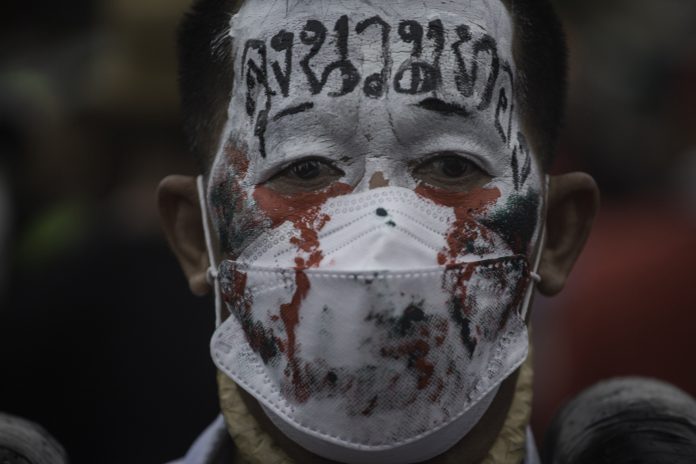When the military junta grabbed power in 2014, it set about reversing Thailand’s earlier trajectory to electoral democracy. A military-backed, monarchy-focussed regime seemed confident when it manufactured a rigged election ‘victory’ in 2019 — but it faced a determined opposition in 2020. In seeking to silence youthful dissenters pursuing constitutional change and monarchy reforms, the regime further subverted public institutions in 2021.
While COVID-19 infection control measures limited protest in 2021, the government’s repressive measures also limited criticism of the regime and monarchy. The year began with intensified royal propaganda, increased internet censorship and a wave of lese majeste arrests. The regime’s repressive measures involved parliament, the judiciary and the police, while also manipulating the media and limiting civil society.
Dominated by the junta-appointed Senate, parliament is used to blunt calls for political reform. A key demand of protesters in 2020 was to reform the junta’s 2017 constitution to make it more democratic, including a demand to limit the monarch’s increased powers. But with assistance from the Constitutional Court, proposals for a body to consider constitutional change were stymied by government parties and the Senate in March 2021. After the Court ruled that amending the constitution required a referendum before parliamentary consideration — and another for the approval of proposed amendments — the reform bill was easily defeated.
A revised effort to achieve constitutional amendment in June saw government parties and the Senate sink a further 12 proposals. Only a coalition party proposal to return to a dual ballot system for constituency and party list MPs in House elections was accepted, presumably because it is likely to benefit the ruling Palang Pracharat Party in future elections.
Protesters had demanded constitutional reform and got none. With the appointed Senate rejecting all reform efforts, parliament remained a reliably undemocratic institution. Packed with loyalist judges, the Constitutional Court is another of the regime’s reliable institutions, preventing both political and social reform. Two of its most significant decisions came in late 2021, when it ruled both monarchy reform and same sex marriage to be unconstitutional.
LGBTQI+ activists had been prominent in the reform protests and the Court’s rejection of same-sex marriage displayed remarkable social conservatism and seeming vindictiveness. In ruling that marriage could only be between biological men and women, it declared others a different species and in need of ‘study’.
The Court also ruled that those calling for reform of the monarchy held ‘hidden’ intent to overthrow the ‘democratic system of government with the king as head of state’ — a decision that made reform seditious. Many of the protesters’ demands amounted to little more than a call for a return to previous constitutions, so the decision was controversial and made clear that the court was protecting the conservative status quo. The decision did not carry legal sanction but, in ordering the respondents to end their movement, the government could arrest and charge those calling for monarchy reform with sedition.
At the street-level, it is the Royal Thai Police that have enforced royalist conservatism. When the junta grabbed power in 2014, it distrusted the police force, considering it aligned with Thaksin Shinawatra, the former prime minister. It was the military that had taken on the pro-Thaksin red shirt protesters and managed the junta’s early crackdown on dissidents.
Now successfully purged, the police have faced off with protesters. Police repression has been combined with aggressive street tactics — especially against working class protesters — as well as thousands of arrests. Indeed, charges of sedition, computer crime, arson and attempted murder against reformists have all been supported by the judiciary. The use of the legal system is meant to damage and delegitimise protesters, rejecting protester claims to the legal and constitutional right to speak out.
This approach, common among authoritarian regimes facing non-violent protest, has brought special attention to those identified as protest leaders. Many have been jailed and denied bail, with 20–30 held in late 2021 — some of them without bail for more than four months. The legal system moves at a snail’s pace on their cases, meaning that they could be held for months, even years.
Reinforcing this strategy, the media has received considerable attention. Journalists have been targeted when reporting protests, with some injured by rubber bullets. Media agencies are pressured to self-censor, not just on the monarchy, but on protester demands and actions. Worried that the Constitutional Court’s ruling on monarchy reform calls as seditious may also apply to those who report such calls, the mainstream media has been muted. Today, few lese majeste cases — of which there are now more than 160 — are reported in the mainstream media.
This ‘lawfare’ approach is also being applied to organisations that report on human rights issues, with Amnesty International facing government investigation. Egged on by ultra-nationalists and royalists, the plan seems to be to silence and deregister human rights NGOs.
Hardly a week goes by without some reformist or protester being fined, jailed or deemed an anti-monarchist bent on destroying the state. Long gone is the short period in 2017–19 where consensus was considered possible. The emphasis is back on repression and suffocating street protest by removing its leaders, thereby limiting social support for reform.
By Kevin Hewison / eurasiareview
The views and opinions expressed in this article are solely those of the author and do not necessarily reflect the position of AsiaWE Review.




